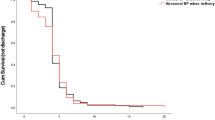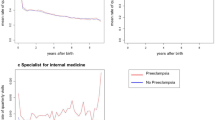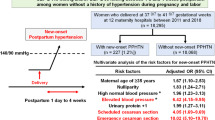Abstract
Objective:
To determine factors associated with lower 6-week postpartum follow-up rates and persistent hypertension among women with preeclampsia with severe features (PEC-S).
Study Design:
Planned secondary analysis of a retrospective cohort study of women with PEC-S. Outcomes were (1) attendance at the 6-week postpartum visit and (2) persistent hypertension.
Results:
One hundred ninety-three women were in the final cohort. The 6-week follow-up rate was 52.3%. Factors associated with lower follow-up were African-American race (OR 0.37 (0.18–0.77)) and <5 prenatal visits (OR 0.44 (0.20–0.97)). Women with diabetes and women with a cesarean had higher follow-up (OR 4.00 (1.09–14.66) and 2.61 (1.40–4.88), respectively). Among those with 6-week follow-up, 21% had persistent hypertension. Obese women, women diagnosed with PEC-S by severe range blood pressure (BP) and women discharged home on BP medication were more likely to have persistent hypertension (OR 3.50 7 (1.06–11.58), 3.58 (1.11-11.54) and 3.04 (1.12–8.23), respectively).
Conclusion:
We identified a subgroup of women at higher risk for poor postpartum follow-up and those at risk for persistent hypertension.
This is a preview of subscription content, access via your institution
Access options
Subscribe to this journal
Receive 12 print issues and online access
$259.00 per year
only $21.58 per issue
Buy this article
- Purchase on Springer Link
- Instant access to full article PDF
Prices may be subject to local taxes which are calculated during checkout
Similar content being viewed by others
References
American College of Obstetricians and Gynecologists; Task Force on Hypertension in Pregnancy. Hypertension in pregnancy: report from the American College of Obstetricians and Gynecologists’ Task Force on Hypertension in Pregnancy. Obstet Gynecol 2013; 122: 1122–1131.
Andersgaard AB, Acharya G, Mathiesen EB, Johnson SH, Straume B, Oian P . Recurrence and long-term maternal health risks of hypertensive disorders of pregnancy: a population-based study. Am J Obstet Gynecol 2012; 206 (143): e1–e8.
Wilson BJ, Watson MS, Prescott GJ, Sunderland S, Campbell DM, Hannaford P, Smith WC . Hypertensive disease of pregnancy and risk of hypertension and stroke in later life: results from cohort study. BMJ 2003; 326: 845.
Bellamy L, Cases JP, Hingorani AD, Williams DJ . Pre-eclampsia and risk of cardiovascular disease and cancer in later life: systematic review and meta-analysis. BMJ 2007; 335: 974.
McDonald SD, Malinowski A, Zhou Q, Yusuf S, Devereaux PJ . Cardiovascular sequelae of preeclampsia/eclampsia: a systematic review and meta-analyses. Am Heart J 2008; 156: 918–930.
NHLBI Workshop. Bridging preeclampsia and future cardiovascular disease. Executive summary 2010. Available at: http://www.nhlbi.nih.gov/meetings/workshops/bridging-pe.htm) (accessed 15 November 2015).
Mozaffarian D, Benjamin EJ, Go AS, Arnett DK, Blaha MJ, Cushman M et al. Heart disease and stroke statistics – 2015 update: a report from the American Heart Association. Circulation 2015; 131: e29–322.
Berks D, Steegers EP, Molas M, Visser W . Resolution of hypertension and proteinuria after preeclampsia. Obstet Gynecol 2009; 114: 1307–1314.
Edlow AG, Srinivas SK, Elovitz MA . Investigating the risk of hypertension shortly after pregnancies complicated by preeclampsia. Am J Obstet Gynecol 2009; 200: e60–e62.
Traylor J, Chandrasekaran S, Limaye M, Srinivas S, Durnwald CP . Risk perception of future cardiovascular disease in women diagnosed with a hypertensive disorder of pregnancy. J Matern Fetal Neonatal Med 2015; 15: 1–6.
Levine LD, Chang J, Merkatz IR, Bernstein PS . Enhanced physician prompts in prenatal electronic medical records impact documentation on smoking cessation. Open J Obstet Gynecol 2013; 3: 717–721.
Levine LD, Elovitz MA, Limaye M, Sammel MD, Srinivas SK . Induction, labor length and mode of delivery: the impact on preeclampsia related adverse maternal outcomes. J Perinatol 2016 (e-pub ahead of print; doi:10.1038/jp.2016.84).
Goel A, Maski MR, Bajracharya S, Wenger JB, Zhang D, Salahuddin S et al. Epidemiology and mechanisms of De Novo and persistent hypertension in the postpartum period. Circulation 2015; 132 (18): 1726–1733.
Brown MC, Bell R, Collins C, Waring G, Robson SC, Waugh J et al. Women’s perception of future risk following pregnancies complicated by preeclampsia. Hypertens Pregnancy 2013; 32: 60–73.
Acknowledgements
This study was funded in part by a career development award in Women’s Reproductive Health Research: K12-HD001265-14.
Author information
Authors and Affiliations
Corresponding author
Ethics declarations
Competing interests
The authors declare no conflict of interest.
Rights and permissions
About this article
Cite this article
Levine, L., Nkonde-Price, C., Limaye, M. et al. Factors associated with postpartum follow-up and persistent hypertension among women with severe preeclampsia. J Perinatol 36, 1079–1082 (2016). https://doi.org/10.1038/jp.2016.137
Received:
Revised:
Accepted:
Published:
Issue Date:
DOI: https://doi.org/10.1038/jp.2016.137
This article is cited by
-
Risk factors associated with attendance at postpartum blood pressure follow-up visit in discharged patients with hypertensive disorders of pregnancy
BMC Pregnancy and Childbirth (2023)
-
Postpartum follow-up of women with preeclampsia: facilitators and barriers — A qualitative study
BMC Pregnancy and Childbirth (2023)
-
New-onset postpartum hypertension in women without a history of hypertensive disorders of pregnancy: a multicenter study in Japan
Hypertension Research (2023)
-
Screening high-risk population of persistent postpartum hypertension in women with preeclampsia using latent class cluster analysis
BMC Pregnancy and Childbirth (2022)
-
Medicaid and moms: the potential impact of extending medicaid coverage to mothers for 1 year after delivery
Journal of Perinatology (2022)



